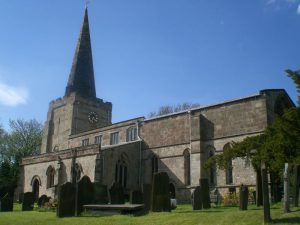History pages
- History map and tour
- Lower Street Farm
- Methodist Chapel
- Reading Room
- The Church
- The Gables
- The Hall
- The Water Mill
- The Well
- The Yew Tree
- Village School
Quicklinks
The Church
St Cuthbert’s stands overlooking the Dove Valley, witness to some 900 years of Christianity in the village of Doveridge. The building does not date from any one period of time but is a conglomeration of architectural styles and changing fashion in decoration and furnishing.

The Christian influence has been active in the area since 653 AD when King Peada established his monastery at Repton and a church may well have occupied the site overlooking the River Dove for several centuries before the Norman Conquest. The earliest mention of the church is to be found in the Doomsday Book of 1086 which records the building as being 42 foot long by 21 feet wide. It was added to during the Norman period though little trace remains of the construction except for the apse, buttresses and a carved wall plate. The tower was refaced with a lift of 15 feet in 1225 AD. The chancel was also added and it’s lancet windows are thought to be the best work of the period to be found in the county. Changes continued to be wrought particularly during the Fourteenth Century where severe alterations were made which are thought to have detracted from the beauty of the church and it’s architectural balance.
Many of the fine objects possessed by the church were disposed of during the reign of Henry VIII but some still remain including a large Deed Chest fitted with three locks requiring three different keys to open it. These were held by the vicar and two church wardens. The oldest plate is a beautiful silver chalice and paten inscribed ‘Doverydge 1619’. Three hatchments hang on the north wall of the Chancel depicting the coats of arms of the Cavendish family and date from between the sixteenth and eighteenth century.
In the grounds of the church can be found an ancient yew tree of huge proportion whose age is estimated to be at least one thousand years and probably more. It may well have been planted when the first church was built in Doveridge. There is also a stone cross which is a combination of old and new. Originally a cross stood on the village green close to the junction of High Street and Pump Lane and may well have originated from 1275 AD. The remains of the shaft were removed from the village centre and incorporated into a new cross which following the end of the First World War was dedicated as a memorial to those from Doveridge who gave their lives in the service of their country.
One other noticeable feature is the clock on the east side of the tower. The present clock dates from 1969 but a clock has been on the tower for a considerable period of time. The wrought iron gates were erected in 1963 in memory of John Martin Brown who was Church Warden for thirty six years.
For those seeking further information a Guide and Brief History is available in the Church and further information is contained in ‘A History of Doveridge’ written by Alan Gibson.
History of the bells
written by Adam Slack
The matter of the Bells is one full of interest, as they all seem to mark some historic or family event.
No. 1. Inscribed:- “John Slater Churchwarden. Edw. Arnold Leicester fecit 1796.” On top of the bell is inscribed “F. Turner.” It was in 1796 that the French under Napoleon attempted the invasion of South Wales, and were speedily driven back; as it was no time for private gifts (Government Stock selling at £50 per cent.) it was probably to mark this deliverance that the bell was provided by the people of the parish.
No. 3. An old bell taken down in 1746 on October 7th, and recast in Uttoxeter for the sum of £12 0s 0d. being returned and re-hung on December 8th 1746. Inscribed:- “H. Wragley made me 1746. Nathaniel Moor, Luke Turner, Churchwardens.” Probably recast in honour of the victory, when Edward the Young Pre-tender in his invasion, had been turned back at Derby, and beaten on April 16th, 1746, at Culloden. This bell was bought 1709. However, the founder is unknown.
No. 4. Inscribed:- “H.W. 1709. W.C. Esq. W. Savage. J. Bladon C.W.” Probably given to celebrate Marlborough’s great victories at Oudenarde and Malplaquet in the wars of the Spanish Succession. The “W.C. Esq.” Probably indicates that William Cavendish was the donor however the founder is unknown.
No. 5. This is undoubtedly a Pre-Reformation bell recast in 1633. Inscribed:- “Som rosa polsata monde Maria vocata, 1633.” Founders’ mark “T.H.” inside a heart. This is a corrupt reading of the old Pre-Reformation inscription – “Sum Rosa Pulsata Mundi Maria Vocata.” Which may be translated – “Rose of the World, I sound your name, around.” The same Latin mistakes are to be found on a bell hanging in the tower at Ibstock; a village in Leicestershire. This bell had probably been out of use for some time, when in 1663, Archbishop Laud made his Visitation and gave instructions “to root out all traces of Puritanism.” As the Puritans were against the use of bells it may be that it was in response to this injunction that the bell was re-cast and put into use again.